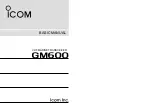
En
3
A somewhat less technical, more leisurely introduction to JPEG
can be found in “The Data Compression Book” by Mark Nelson
and Jean-loup Gailly, published by M&T Books (New York), 2nd
ed. 1996, ISBN 1-55851-434-1. This book provides good
explanations and example C code for a multitude of compression
methods including JPEG. It is an excellent source if you are
comfortable reading C code but don’t know much about data
compression in general. The book’s JPEG sample code is far from
industrial-strength, but when you are ready to look at a full
implementation, you’ve got one here...
The best currently available description of JPEG is the textbook
“JPEG Still Image Data Compression Standard” by William B.
Pennebaker and Joan L. Mitchell, published by Van Nostrand
Reinhold, 1993, ISBN 0-442-01272-1.
Price US$59.95, 638 pp. The book includes the complete text of
the ISO JPEG standards (DIS 10918-1 and draft DIS 10918-2).
Although this is by far the most detailed and comprehensive
exposition of JPEG publicly available, we point out that it is still
missing an explanation of the most essential properties and
algorithms of the underlying DCT technology.
If you think that you know about DCT-based JPEG after reading
this book, then you are in delusion. The real fundamentals and
corresponding potential of DCT-based JPEG are not publicly
known so far, and that is the reason for all the mistaken
developments taking place in the image coding domain.
The original JPEG standard is divided into two parts, Part 1 being
the actual specification, while Part 2 covers compliance testing
methods. Part 1 is titled “Digital Compression and Coding of
Continuous-tone Still Images, Part 1: Requirements and
guidelines” and has document numbers ISO/IEC IS 10918-1, ITU-
T T.81. Part 2 is titled “Digital Compression and Coding of
Continuous-tone Still Images, Part 2: Compliance testing” and has
document numbers ISO/IEC IS 10918-2, ITU-T T.83.
IJG JPEG 8 introduces an implementation of the JPEG SmartScale
extension which is specified in a contributed document at ITU and
ISO with title “ITU-T JPEG-Plus Proposal for Extending ITU-T
T.81 for Advanced Image Coding”, April 2006, Geneva,
Switzerland. The latest version of the document is Revision 3.
The JPEG standard does not specify all details of an
interchangeable file format. For the omitted details we follow the
“JFIF” conventions, revision 1.02. JFIF 1.02 has been adopted as
an Ecma International Technical Report and thus received a formal
publication status. It is available as a free download in PDF format
from http://www.ecma-international.org/publications/techreports/
E-TR-098.htm.
A PostScript version of the JFIF document is available at
http://www.ijg.org/files/jfif.ps.gz.
There is also a plain text version at
http://www.ijg.org/files/jfif.txt.gz, but it is missing the figures.
The TIFF 6.0 file format specification can be obtained by FTP
from ftp://ftp.sgi.com/graphics/tiff/TIFF6.ps.gz.
The JPEG incorporation scheme found in the TIFF 6.0 spec of 3-
June-92 has a number of serious problems.
IJG does not recommend use of the TIFF 6.0 design (TIFF
Compression tag 6).
Instead, we recommend the JPEG design proposed by TIFF
Technical Note #2
(Compression tag 7). Copies of this Note can be obtained from
http://www.ijg.org/files/.
It is expected that the next revision of the TIFF spec will replace
the 6.0 JPEG design with the Note’s design.
Although IJG’s own code does not support TIFF/JPEG, the free
libtiff library uses our library to implement TIFF/JPEG per the
Note.
ARCHIVE LOCATIONS
The “official” archive site for this software is www.ijg.org.
The most recent released version can always be found there in
directory “files”. This particular version will be archived as
http://www.ijg.org/files/jpegsrc.v8b.tar.gz,
and in Windows-compatible “zip” archive format as
http://www.ijg.org/files/jpegsr8b.zip.
The JPEG FAQ (Frequently Asked Questions) article is a source of
some general information about JPEG.
It is available on the World Wide Web at
http://www.faqs.org/faqs/jpeg-faq/
and other news.answers archive sites, including the official
news.answers archive at rtfm.mit.edu:
ftp://rtfm.mit.edu/pub/usenet/news.answers/jpeg-faq/.
If you don’t have Web or FTP access, send e-mail to
[email protected]
with body
send usenet/news.answers/jpeg-faq/part1
send usenet/news.answers/jpeg-faq/part2
ACKNOWLEDGMENTS
Thank to Juergen Bruder for providing me with a copy of the
common DCT algorithm article, only to find out that I had come to
the same result in a more direct and comprehensible way with a
more generative approach.
Thank to Istvan Sebestyen and Joan L. Mitchell for inviting me to
the ITU JPEG (Study Group 16) meeting in Geneva, Switzerland.
Thank to Thomas Wiegand and Gary Sullivan for inviting me to the
Joint Video Team (MPEG & ITU) meeting in Geneva, Switzerland.
Thank to John Korejwa and Massimo Ballerini for inviting me to
fruitful consultations in Boston, MA and Milan, Italy.
Thank to Hendrik Elstner, Roland Fassauer, Simone Zuck,
Guenther Maier-Gerber, Walter Stoeber, and Fred Schmitz for
corresponding business development.
Thank to Nico Zschach and Dirk Stelling of the technical support
team at the Digital Images company in Halle for providing me with
extra equipment for configuration tests.
Thank to Richard F. Lyon (then of Foveon Inc.) for fruitful
communication about JPEG configuration in Sigma Photo Pro
software.
Continues to the
next page



































